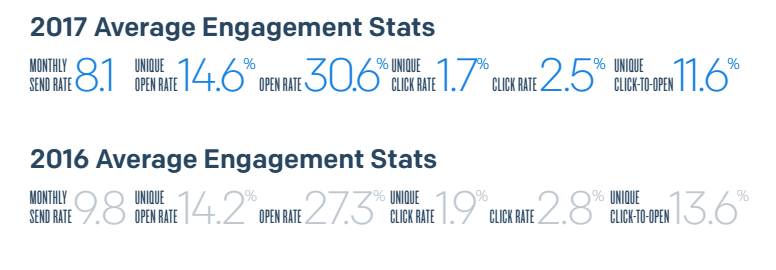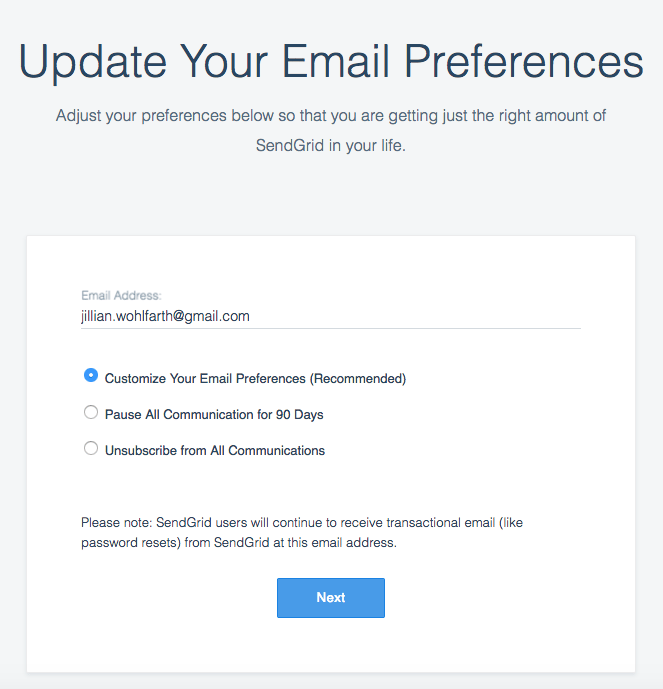Sending email at the right frequency can be a challenge. As an email marketer, how many marketing emails
should you send a month? And as a recipient, how many are you ok with receiving?
As a sender, you should ensure that you provide enough touch points with customers/prospects to keep them interested and loyal to your brand. For recipients, you want to receive updates on relevant offers and information at a cadence that adds value to your day.
So how do you find the right balance? If you are a sender, testing is always your best bet. A/B test varying frequencies for your campaigns to find where you see the most engagement. This number will be different for every sender, so it can be helpful to look at some benchmarks to help compare your program against.
So let’s dive into some stats from our
2017 Global Email Benchmark Report. Earlier this year, we analyzed nearly 50 billion messages to over 100,000 different senders in the top 25 industries who sent email through SendGrid.
The average send rate for senders in this study was 8.1 times a month. Send rates across all industries ranged from 3 emails a month on the low end to up to 25 emails per month. For comparison, in 2016, the average monthly send rate was around 9.8 monthly emails. So most industries decreased their sending frequency from 2016 to 2017.

There was an outlier for send rate trends from 2016 to 2017—dating sites. As a whole, these sites went from sending 15 messages per month in 2016 to 25 messages per month in 2017!
Now, this could be affected by a few high volume senders in the industry, but we wanted to dig a little deeper to see what effect this increase had on engagement. The news wasn’t good. Dating sites dipped from an 18.8% average open rate in 2016 to a 10% average open rate in 2017. Unique open to click rates also suffered, decreasing from 27.4% in 2016 to 21% in 2017. We saw this same negative engagement trend with industries that also increased their sending frequency year-over-year.
Decreases in engagement (open, clicks, unsubscribes) generally reflect discontent or disinterest from your recipients. This can often mean that you’re sending too much email. (We might be looking at you dating sites!)
Let me share a personal example. Below is a screenshot of my inbox from the holidays last year.

I bought an item from this vendor in early December and then received an email from them
every day thereafter...until I unsubscribed. (
Which I have a tendency to do.) In this case, 9 days of consecutive non-engagement should have shown this sender that I was losing interest. Instead of proceeding full steam ahead, they should have solicited my feedback on my email frequency preferences, or slowed their cadence automatically. Had I been put into a weekly or monthly email segment instead of daily, I bet I would have stayed subscribed!
Examples like this are why A/B testing is
so important. Don’t make big shifts in your sending frequency because you have a new product to promote or because you just won a bunch of new customers. If you do, you run the risk of tiring them out to the point of no return. Ease your way up and see how your recipients react. The inbox is already a crowded place. Don’t overcrowd it.
So what can you do if you notice your email engagement suffering?
1)
Implement a re-engagement campaign to try to win back recent non-engagers. Including an offer in your re-engagement campaign always helps, but keep in mind that actions speak louder than words and non-engagement usually means it’s time to remove your non-responders altogether.
2)
Offer a down subscribe option. A down subscribe option gives your recipients a chance to take a pause from your email for a specified amount of time without having them unsubscribe altogether. (This is particularly helpful during the holidays, when users' inboxes are inundated with email, like in my example above!) We offer a 90-day pause for our recipients at SendGrid and have seen it be quite successful.

3)
Implement a preference center. Creating preference centers are simply the best way to give your recipients control of their inbox. For inspiration, I wrote about one of my favorite preference centers in my post,
Email Preference Center Perfection.
Lastly, I think it’s important to quickly mention that you shouldn’t send email just for the sake of casting a wide net and hoping someone opens and clicks! It’s all about being motivated by your recipients’ actions and wanting to provide value to them. Here are a few examples of when it might be appropriate to send a marketing email:
- When an event is happening in a city/area where your recipient has attended previously
- When an offer is available for a similar purchase your recipient has already made
- When you have new content available that your recipient has shown prior interest in
- When you have curated content of interest to your recipient to send in a newsletter
- In accordance with the content they requested in your preference center
All of these are predicated off of specific actions or preferences of your individual subscribers. If you listen to your subscribers (through both your preference center and their engagement statistics) you’ll find the perfect balance of sending at the right frequency and avoiding email fatigue.
For more specific sending frequency stats, check out our
2017 Global Email Benchmark Report.




